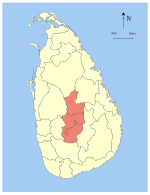Kandy
Kandy
මහනුවර கண்டி | |
|---|---|
Sri Lanka Time) | |
| Postal code | 20000 |
| Area code | 081 |
| Website | kandy |
Kandy (
colonial expansion and occupation.Etymology
The city and the region have been known by many different names and versions of those names. Some scholars suggest that the original name of Kandy was Katubulu Nuwara located near the present Watapuluwa. However, the more popular historical name is Senkadagala or Senkadagalapura, officially Senkadagala Siriwardhana Maha Nuwara (meaning 'great city of Senkadagala of growing resplendence'), generally shortened to 'Maha Nuwara'. According to folklore, this name originated from one of the several possible sources. One being the city was named after a brahmin with the name Senkanda who lived in a cave nearby, and another being a queen of Vikramabahu III was named Senkanda, and after a coloured stone named Senkadagala. The Kingdom of Kandy has also been known by various names. The English name Kandy, which originated during the colonial era, is derived from an anglicised version of the Sinhala Kanda Uda Rata (meaning the land on the mountain) or Kanda Uda Pas Rata (the five counties/countries on the mountain). The Portuguese shortened this to "Candea", using the name for both the kingdom and its capital. In Sinhala, Kandy is called Maha Nuwara, meaning "Great City" or "The Capital", although this is most often shortened to Nuwara in daily use.[3]
History
Founding
Historical records suggest that Kandy was first established by the Vikramabahu III (1357–1374 AD), who was the monarch of the Kingdom of Gampola, north of the present city, and named Senkadagalapura at the time.
Kandyan Kingdom
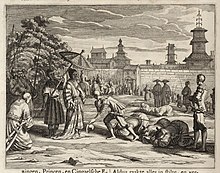
History of Kandy |
|---|
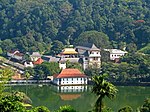 |
| Kingdom of Kandy (1469–1815) |
|
| Colonial Kandy (1815–1948) |
| Kandy (1948–present) |
| See also |
|
|
In 1592 Kandy became the capital city of the last remaining independent kingdom in the island after the coastal regions had been conquered by the
The kingdom tolerated a Dutch presence on the coast of Sri Lanka, although attacks were occasionally launched. The most ambitious offensive was undertaken in 1761, when King
The Dutch launched a better-adapted force in January 1765, replacing their troops' bayonets with machetes and using more practical uniforms and tactics suited to jungle warfare. The Dutch were initially successful in capturing the capital, which was deserted, and the Kandyans withdrew to the jungles once more, refusing to engage in open battle. However, the Dutch were again worn down by constant attrition.
As the capital, Kandy had become home to the relic of the tooth of the Buddha which symbolizes a 4th-century tradition that used to be linked to the Sinhalese monarchy, since the protector of the relic was the ruler of the land. Thus the Royal Palace and the Temple of the Tooth were placed in close proximity to each other.
The last ruling dynasty of Kandy was the Nayaks. Kandy stayed independent until the early 19th century.

In the
Colonial era
During the
In 1848 led by
The rebellion began on 26 July 1848 with Gongalegoda Banda, crowned as king, and Puran Appu, as prime minister, and their main objective was to capture Kandy back from the British. The Matale Rebellion was a peasant revolt in the hands of the

In 1944, during World War II, the South East Asia Command of the allies was moved to Kandy, where it remained until the end of the war.
Contemporary Kandy
It is the second-largest city of the island and the capital of the Central Province of modern Sri Lanka. Its geographic location has made it a major transportation hub in the island: while Kandy being the gateway to the Central Highlands[4] of Sri Lanka, the city can be reached by major motorways in every direction of the island. The railway line from Colombo, the seaport on the western coast runs via Kandy to the farthest point of Badulla[5] in the Central Highlands. The main roads Colombo-Kandy and Kandy-Nuwara Eliya[6] are two of the most scenic roads of Sri Lanka; Colombo-Kandy[7] road passes through the rubber, tea plantations and rice paddies, Kandy-Nuwara Eliya road cuts through paddy fields and seamless tea plantations. Both roads claw their way up winding, rounding over the rings of hills. Currently, feasibility studies are afoot for another highway between Colombo and Kandy via Kadawata and the scenic city of Katugastota.
Geography and climate

Topography
Kandy is located in the mountainous and thickly forested interior of the island. The city is located in between multiple mountain ranges including the
Climate
In
| Climate data for Kandy | |||||||||||||
|---|---|---|---|---|---|---|---|---|---|---|---|---|---|
| Month | Jan | Feb | Mar | Apr | May | Jun | Jul | Aug | Sep | Oct | Nov | Dec | Year |
| Mean daily maximum °C (°F) | 27 (81) |
28 (82) |
30 (86) |
30 (86) |
29 (84) |
28 (82) |
27 (81) |
28 (82) |
28 (82) |
28 (82) |
27 (81) |
27 (81) |
28 (83) |
| Daily mean °C (°F) | 23.1 (73.6) |
24.1 (75.4) |
25.4 (77.7) |
25.9 (78.6) |
25.6 (78.1) |
24.8 (76.6) |
24.3 (75.7) |
24.4 (75.9) |
24.3 (75.7) |
24.3 (75.7) |
24 (75) |
23.7 (74.7) |
24.5 (76.1) |
| Mean daily minimum °C (°F) | 18 (64) |
18 (64) |
18 (64) |
20 (68) |
20 (68) |
20 (68) |
20 (68) |
19 (66) |
19 (66) |
19 (66) |
19 (66) |
18 (64) |
19 (66) |
| Average precipitation mm (inches) | 79 (3.1) |
74 (2.9) |
71 (2.8) |
188 (7.4) |
144 (5.7) |
132 (5.2) |
128 (5.0) |
113 (4.4) |
155 (6.1) |
264 (10.4) |
296 (11.7) |
196 (7.7) |
1,840 (72.4) |
| Average rainy days | 6 | 5 | 8 | 14 | 11 | 15 | 14 | 13 | 13 | 17 | 16 | 14 | 146 |
| Mean daily sunshine hours | 7 | 8 | 8 | 7 | 6 | 6 | 6 | 6 | 6 | 6 | 6 | 6 | 7 |
| Source 1: Weather2Travel for highs, lows and sunshine,[12] Climate-Data.org for daily mean temperatures (altitude: 518 m)[8] | |||||||||||||
| Source 2: World Climate Guide,[13] HolidayCheck.com,[14] World Climate[15] | |||||||||||||
Cityscape
The city of Kandy lies at an elevation of 465 metres (1,526 ft) above sea level. Its plan developed around two open spaces: an elongated square, at the end of which are the administration buildings of the old capital, and an artificial lake that is quadrangular in form. A public garden adds to the openness of the city's spatial organization.
Kandy has now grown out to encompass Peradeniya, home to the University of Peradeniya and the Botanical Gardens, Katugastota to the north, and east to Kundasale, Tennekumbura and Gurudeniya.
Neighbourhoods
- Akurana
- Ampitiya
- Ampitiya North
- Ampitiya South
- Anniwatta
- Aruppola East
- Asgiriya
- Bahirawakanda
- Bogambara
- Bogodawatta
- Bowala
- Buwelikada
- Dangolla
- Deiyannewelle
- Etamoragodawatta Colony
- Gannoruwa West
- Gelioya
- Gampola
- Heenagama
- Katugastota
- Katukele
- Kosgaspitiya
- Kotugodella
- Lewella
- Madawala
- Mahaiyawa
- Malwatta
- Mapanawatura
- Mavilmada
- Menikkumbura
- Mulgampola
- Navayalatenna
- Nittawela
- Nuwara Dodanwala
- Peradeniya
- Polgolla
- Siyabalapitiya
- Siyambalagastenna
- Suduhumpola East
- Suduhumpola West
- Talwatta
- Tennekumbura
- Udamadapola
- Udathalawinna
- Watapuluwa
- Wattarantenna
- Wewelpitiya
- Yatiwawala
- Wattegama
Wards
Government
Kandy Municipal Council මහනුවර මහ නගර සභා | |
|---|---|
proportional representation system | |
Last election | 2018 Sri Lankan local elections |
| Website | |
| kandy | |
Kandy is a
The Kandy Municipal Council governs the City of Kandy, it was established under the Municipalities Ordinance of 1865. The inaugural meeting had been held on 20 March 1866. The Kandy Town Hall was established in the present premises known as the Dunuwille Walawwe in 1870.[19]
The
As of the 2018 election, the council consists of 41 members. The UNP has 19, the SLPP 16, the UPFA 3, the JVP 2, and the UPA one. The Council meets once a month to review the progress and decide on the implementation of its projects. Five standing committees of the council, namely Finance, Law, Works, Sports and Welfare Services (Pre-Schools, Library), also meet monthly to evaluate and recommend to Council relative matters for approval.
Demographics
Kandy is a Sinhalese majority city; there are sizable communities belonging to other ethnic groups, such as Moors and Tamils. The city remains an important religious centre of the Sinhalese and a place of pilgrimage for Buddhists, namely those belonging to the Theravada school. The Catholic Church has a diocese headquartered in the city.
Census of population (2012)
| Ethnicity | Population | % Of Total |
|---|---|---|
| Sinhalese | 118,209 | 74.55 |
| Sri Lankan Moors | 17,282 | 10.90 |
| Sri Lankan Tamils | 15,203 | 9.59 |
| Indian Tamils | 5,601 | 3.53 |
| Other (including Burgher, Malay) | 2,269 | 1.43 |
| Total | 158,564 | 100 |
Source:statistics.gov.lk
Population by ethnicity according to urban area (2007)
| Ethnicity | Population | % Of Total |
|---|---|---|
| Sinhalese | 77,560 | 70.48 |
| Sri Lankan Moors | 15,326 | 13.93 |
| Sri Lankan Tamils | 9,427 | 8.57 |
| Indian Tamils | 5,245 | 4.77 |
| Other (including Burgher, Malay) | 2,489 | 2.26 |
| Total | 110,049 | 100 |
Source:statistics.gov.lk
Economy
It is the second-largest city in the island and the capital of Central Province. Many major corporations have large branch offices in Kandy and many industries including textiles, Sri Lankan gemstones, furniture, information technology, and jewellery are found there. Many agriculture research centres are located throughout the city.
Health care
The
The
The Dental Hospital Peradeniya and Sirimavo Bandaranaike Children's Hospitals are located adjacent to the Peradeniya Teaching Hospital.[21]
Infrastructure
Transportation
Kandy has a public transport system based primarily on buses. The bus service is operated both by private companies and the government's own Sri Lanka Transport Board (SLTB). The Kandy Multimodal Transport Terminal (KMTT) after constructed will integrate a major bus terminal to the Kandy railway station. KMTT will handle about 2,000 bus departures, up to 3,000 further through-services, and about 320,000 passenger movements on a daily basis. EoIs from consultants for the Design, Construction Supervision and Contract Administration of the project were called in 2016.[22]
Air
The proposed Kandy Airport in the nearby area of Kundasale will create a direct air link to Bandaranaike International Airport in Colombo.[23] The new airport will act as a catalyst to the tourism industry in Sri Lanka.
Roads
- A-Grade highways
- A1 highway(Kandy road) connects Colombo with Kandy.
- A9 highway connects Jaffna with Kandy.
- A26 highwayconnects Padiyathalawa with Kandy via Mahiyangana.
- A10 highway connects Puttalam with Kandy via Kurunegala and Katugastota.
- A5 highway connects Chenkalady with Kandy via Padiyathalawa Badulla Nuwara Eliya and Peradeniya.
- High-speed expressways
- Colombo – Kandy high-speed elevated expressway running is currently under construction, providing a high-speed link between the two largest economic centres.
Rail
- Matale Line of the Sri Lanka Railways connects Kandy by way of Peradeniya and Matale. It connects to the Main Line that links Colombo and Badulla
Architecture

Temple of the Tooth
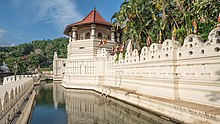
On the north shore of the lake, which is enclosed by a parapet of white stone dating to the beginning of the 19th century, are the city's official religious monuments, including the
The monumental ensemble of Kandy is an example of construction that associates the Royal Palace and the Temple of the Tooth (Palace of the tooth relic) is the place that houses the relic of the tooth of the Buddha. Originally part of the Royal Palace complex of the Kandyan Kingdom, it is one of the holiest places of worship and pilgrimage for Buddhists around the world. It was the last of a series of temples built in the places where the relic, the actual palladium of the Sinhalese monarchy, was brought following the various relocations of the capital city.
The Palace of the Tooth relic, the palace complex and the holy city of Kandy are associated with the history of the dissemination of Buddhism. The temple is the product of the last peregrination of the relic of the tooth of Buddha and the testimony of a religion which continues to be practiced today.
The
Royal Palace

The
Lankatilaka Temple
The Lankatilaka Temple is considered to be one of the best-preserved examples of traditional Sinhalese temple architecture.[citation needed] Built on a rock, the temple is reached by a long series of rock-cut steps. An arched passage of the image house leads through a Mandapa (hall) into the inner sanctum which is decorated with floral designs. The two side walls and the ceiling are decorated with paintings. In the inner sanctum is a large seated image of the Buddha.
Gadaladeniya Temple
The Gadaladeniya Temple's design is of South Indian origin with a Devale attached to it, similar in character to the Natha Devale and the Gedige of Adahana Maluwa. The main shrine room has a seated Buddha statue and the remains of some paintings of the Gampola period.
Among other important temples around Kandy[25] are Dodanwala Devalaya (shrine), Embekka Devalaya (shrine), Galmaduwa Vihara temple, Handagala Vihara temple, Medawala Vihara and Nalanda Gedige.
Parks and gardens
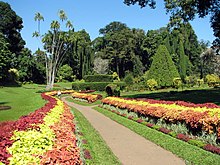
The
The
Education
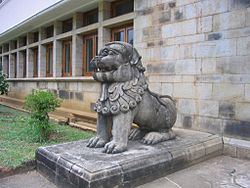
Primary and secondary education
Kandy is home to some of the island's oldest and leading schools.
- Dharmaraja College
- Girls' High School, Kandy
- Good Shepherd Convent, Kandy
- Hemamali Girls College
- Gothami Girls College
- Hillwood College
- Kingswood College
- Mahamaya Girls' College, Kandy
- Pushpadana Girls' College, Kandy
- Ranabima Royal College
- St. Anthony's College, Kandy
- St. Anthony's Girls College
- St. Benedict's College, Kandy
- St. Sylvester's College
- Sarasavi Uyana College
- Seethadevi Girls' College
- Sri Chandananda Buddhist College
- Sri Rahula College
- Swarnamali Girls College
- Trinity College Kandy
- Vidyartha College
- Viharamahadevi Girls College
- Wariyapola Sri Sumangala College
Tertiary education
The country's second-oldest university, University of Peradeniya is situated in Peradeniya, while the Open University of Sri Lanka, the Sri Lanka Institute of Information Technology, the National Institute of Business Management and the College of Technology have centres in the city. Most of the private-sector higher educational institutions also have their branches in Kandy.[27]
The Geology Department at the University of Peradeniya is the only earth science department in Sri Lanka.
Culture
| UNESCO World Heritage Site | |
|---|---|
 The Temple of the Tooth Relic in Kandy | |
| Criteria | Cultural: iv, vi |
| Reference | 450 |
| Inscription | 1988 (12th Session) |
Leisure and entertainment

Kandyans do many things for leisure and entertainment in the city. Kandy is popular due to the annual
Kandy City Centre is commercial and shopping complex open in 2005[28] at Dalada Veediya.[29] and is the most modern commercial complex in Kandy. The complex is studded with ultra-modern features, also incorporating the traditional architecture of Kandy during the medieval period of Sri Lanka. The city centre is host to several leading banks, a fully equipped supermarket, modern restaurants, an entertainment zone including a 3-cinema complex, a well-designed state-of-the-art food court, Sri Lanka's leading bookshop, flora, and an Ayurveda site. There is a five-level car park outside managed separately by the Kandy Municipal Council and is the largest car park in Kandy.
Literature, film and television
Much of the 1984 film Indiana Jones and the Temple of Doom was shot in Kandy.
Sport

Kandy has produced national-level competitors in a wide range of sports, including cricket, rugby union, Association football, swimming, field hockey, athletics, table tennis, boxing, basketball, golf, and even baseball, which has only been introduced into Kandy recently. Kandy has produced national captains of cricket and rugby and athletes that play at the highest level of all sports.
Unlike the rest of the country
Cricket is widely played in Kandy with the city having three first-class teams in the
Sports like
Twin towns and sister cities
The City of Kandy has a sister city relationship with:
| Country | City | Province | Year |
|---|---|---|---|
| Ayudhya | Ayutthaya
|
2013[31] | |
| Chengdu | Sichuan | 2015[32] |
See also
- Esala Perahera
- Kingdom of Kandy
- World Heritage Sites of Sri Lanka
 Sri Lanka portal
Sri Lanka portal
References
- ^ "Major Cultural Assets/Archaeological Sites". Department of Archaeology Sri Lanka. Archived from the original on 29 March 2010. Retrieved 24 October 2010.
- ^ "Sacred City of Kandy". UNESCO. Retrieved 1 May 2017.
- ^ a b c "Kandy Map". SriLankanMap. Retrieved 23 June 2011.
- ^ "Central highlands (Hill country) of Sri Lanka". Retrieved 24 October 2010.
- ^ "Badulla, Central Highlands of Sri Lanka". Retrieved 24 October 2010.
- ^ "Kandy – Nuwara Eliya Road". Retrieved 24 October 2010.
- ^ "Colombo – Kandy Road". Retrieved 24 October 2010.
- ^ a b "Climate: Kandy CP (altitude: 518 m) – Climate graph, Temperature graph, Climate table". Climate-Data.org. Retrieved 12 December 2013.
- ^ "Kandy Weather". eZeeStay. Archived from the original on 26 March 2012. Retrieved 22 June 2011.
- ^ "Kandy Weather and When to Go". TripAdvisor. Retrieved 22 June 2011.
- ^ "Kandy". tsitours. Retrieved 22 June 2011.
- ^ "Best Weather in Kandy, Sri Lanka". Weather2Travel. Retrieved 12 November 2013.
- ^ www.worldclimateguide.co.uk. "Kandy Climate Guide, Sri Lanka – World Climate Guide".
- ^ Temperature Kandy – climate Kandy Sri Lanka (Inside) – weather Kandy Archived 25 January 2013 at archive.today
- ^ "World Climate: N07E080 – Weather history for travel real estate and education".
- ^ "City Profile". Kandy Municipal Council. Archived from the original on 13 December 2014. Retrieved 7 December 2014.
- ^ "City History". Kandy Municipal Council. Archived from the original on 13 December 2014. Retrieved 7 December 2014.
- Sunday Times. Retrieved 13 April 2018.
- ^ "The History of the Municipal Council". 19 June 2009. Archived from the original on 25 September 2010. Retrieved 24 October 2010.
- ^ "Home". kandy-hospital.health.gov.lk.
- ^ "Teaching Hospital Peradeniya". peradeniya-hospital.health.gov.lk.
- ^ "Consultancy for KMTT design and construction supervision" (PDF). Archived from the original (PDF) on 2 February 2017. Retrieved 30 January 2017.
- ^ Maryam Azwer (5 August 2012). "Kandy Airport Most Likely in Kundasale – Chief Minister". The Sunday Leader. Archived from the original on 11 December 2011. Retrieved 5 August 2012.
- ^ The splendour of International Buddhist Museum, Kandy, The Nation, Mallika Etulgama, 2011/09/18
- ^ "Temple Excursions Around Kandy, Sri Lanka". Retrieved 24 October 2010.
- ^ a b Royal Botanic Gardens Peradeniya Official Guide Map 2013
- ^ "University of Peradeniya".
- ^ "Home". pfik.org.
- ^ "Sri Dalada Maligawa". Retrieved 24 October 2010.
- ^ Marikar, Hafiz. "A Look at Sports in Kandy". The Sunday Leader. Retrieved 22 June 2011.
- ^ Wimalasurendre, Cyril (22 August 2013). "Kandy becomes Ayoddhya's sister city". The Island. Retrieved 5 May 2016.
- ^ Wimalasurendre, Cyril (7 April 2015). "Kandy ties up with sister city in China". The Island. Retrieved 5 May 2016.
Further reading
- Woodcock, George. "The Kings of Kandy" History Today (Dec 1963) 13#12 pp 852–862, covers 1505 to 1833.
- Seneviratna, Anuradha (2008). The Kandy Asala Perahara. Sri Lanka: Vijitha Yapa Publications. ISBN 978-955-665-017-4. Archived from the originalon 10 August 2010. Retrieved 11 November 2010.
- Seneviratna, Anuradha (1999). World Heritage City of Kandy, Sri Lanka: Conservation and Development Plan. Sri Lanka: Central Cultural Fund. ISBN 978-955-613-126-0.
- Seneviratna, Anuradha (2008). Gateway to Kandy – Ancient monuments in the central hills of Sri Lanka. Sri Lanka: Vijitha Yapa Publications. ISBN 978-955-665-031-0. Archived from the originalon 16 July 2011. Retrieved 11 November 2010.
- Seneviratna, Channa (2004). Kandy at War: Indigenous Military Resistance to European Expansion in Sri Lanka 1594–1818. Manohar. ISBN 978-81-7304-547-9.





